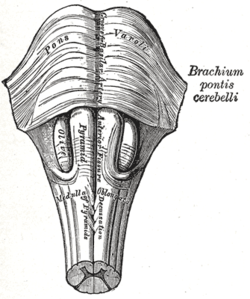Decussation of pyramids
| Medullary pyramid (brainstem) |
|
|---|---|

Medulla oblongata and pons. Anterior surface. (Pyramid visible at center.)
|
|
| Details | |
| Identifiers | |
| Latin | pyramis medullae oblongatae |
| NeuroNames | hier-702 |
| Dorlands /Elsevier |
p_44/12683083 |
| TA | A14.1.04.003 |
| FMA | 75254 |
|
Anatomical terms of neuroanatomy
[]
|
|
The medullary pyramids are paired white matter structures of the brainstem's medulla oblongata that contain motor fibers of the corticospinal and corticobulbar tracts – known together as the pyramidal tracts. The lower limit of the pyramids is marked when the fibers cross (decussate).
The ventral portion of the medulla oblongata contains the medullary pyramids. These two ridge-like structures travel along the length of the medulla oblongata and are bordered medially by the anterior median fissure. They each have an anterolateral sulcus along their lateral borders, where the hypoglossal nerve emerges from. Also at the side of each pyramid there is a pronounced bulge known as an olive. Fibers of the posterior column, which transmit sensory and proprioceptive information, are located behind the pyramids on the medulla oblongata.
The medullary pyramids contain motor fibers that are known as the corticobulbar and corticospinal tracts. The corticospinal tracts are on the anterior surface of the pyramids. These tracts transport motor signals that originated in the precentral gyrus and travelled through the internal capsule to the medulla oblongata and pyramids. Extrapyramidal tracts are those motor tracts that do not traverse the medullary pyramids.
At the pyramids' most caudal end, the corticospinal axons decussate (or cross over) the midline and continue down the spinal cord on the contralateral side. The fibers that decussated will go down the lateral corticospinal tract while the fibers that did not decussate will travel down the anterior corticospinal tract. Nearly 90 percent of the fibers decussate and travel down the lateral corticospinal tract while the other 10 percent travels down the anterior corticospinal tract.
...
Wikipedia
